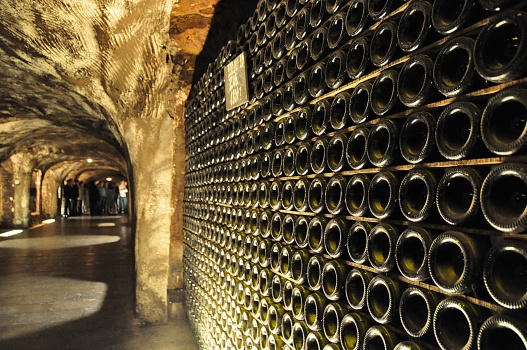Property 1465 – Champagne Hillsides, Houses and Cellars
Property 1425 – The Climats, Terroirs of Burgundy
Champagne hillsides, houses and cellars
The Champagne region of France must have had a hell of a publicist back in the 17th and 18th centuries. Whatever was said about the product back then has clearly echoed down through the ages. They managed to convince the nobility to drink a great deal of the wine produced in the area, resulting in an aura of refinement and class which is in heavy demand in our age of mass-produced products. This does nothing to take away from the obvious skill of the wine producers in the Champagne region. However I’m fascinated to see how a 300 year old marketing campaign has resulted in modern day people falling in to raptures at the mention of the word.
How does this relate to the UNESCO world heritage list? Well, apart from producing a delightful beverage the Champagne region of France has been nominated as an example of a “cultural landscape”. That is to say, the Champagne region is a place where human hands have interacted with the land over millennia, producing a unique environment with universal value. The landscape is a classic combination of rolling green hills frequently containing, dotted with small medieval towns. It’s obvious how intensely cultivated the land has been, but also how much people care about it. This is particularly remarkable given that Champagne was the front line during World War 1 – only a hundred years ago this place was a wrecked battlefield.
The most interesting parts of Champagne are actually underground. Beneath the fertile soils lies soft stone which can easily be dug out to form huge networks of caves. These caves have been used for hundreds of years to store wine at stable temperatures without the need for refrigeration.
Entering these caves as part of a tour of one of the wineries, I found it to be quite a spooky experience. The walls of each chamber are lined with hundreds of bottles of sparkling wine which are labelled in handwriting of arcane difficulty. The lighting is kept deliberately low, meaning that illumination drops off sharply the further one walks from the tour group. Although I can’t prove it, it seems like this would be the place that you’d hide Nazi war gold or unwanted prisoners during periods of upheaval.
Champagne is an easy day trip from Paris (or Brussels if you happen to be there). Most of the large wineries run tours of their facilities regularly along with tastings. If time permits it’s worth simply driving around the area avoiding the main roads to try to soak up the feeling of the countryside.
The climat, terroirs of Burgundy
Terroir is a French word which refers to all of the environmental factors which might affect a crop such as wine grapes. This could include soil, location on a hillside or on a plain, the relationship to water, farming practices and local climatic idiosyncrasies. In French winemaking, particularly in the region of Burgundy, there is a belief that the role of the vigneron is to bring out the terroir of the land through the medium of wine. This is seen as a kind of shepherding of characteristics rather than creation from whole cloth. The deep involvement of the idea of terroir in Burgundy winemaking meets the criteria for a UNESCO cultural landscape and World Heritage nomination.

The vineyards of Burgundy are just as quintessentially French as those of Champagne, while also being very different to the eye. The fields have a browner, more mediterranean look to them and it seemed to me that there was a faintly alpine tang to the air. However the land is also peppered with small woods, often with streams passing through them which give it a magical, fairytale air.

I visited for a wedding and stayed in the nearby town of Beaune. Our hotel was a converted stables and seemed not to have had significant structural work since the 18th century. In other places it would have been run down but in Burgundy it was charming.
It’s immediately apparent that the town runs on wine. Wine shops are on every corner, but they are relatively uninfested with large tourist groups. A wander through town leads to a pretty market square, and the edge of town affords views of the nearest climats (vineyard parcels).
For visitors to the area the best thing to do is probably to rent an apartment and lay in stocks of cheese and wine. What better way to appreciate the cultural landscape of Burgundy than by ingesting the culture.



Just returned from a trip to Epernay and Beaune. We make annual trips to Burgundy, sometimes 2-3 times and we have friends, French winemakers, in Beaune, Pommard, Meursault and further north in Chablis. There is nothing like the annual invitation to taste from the barrel the previous years vintage ….. very special! Our favourite wine and wine region!
LikeLike
It’s lovely, isn’t it? I love that such a unique landscape has World Heritage listing.
LikeLiked by 1 person